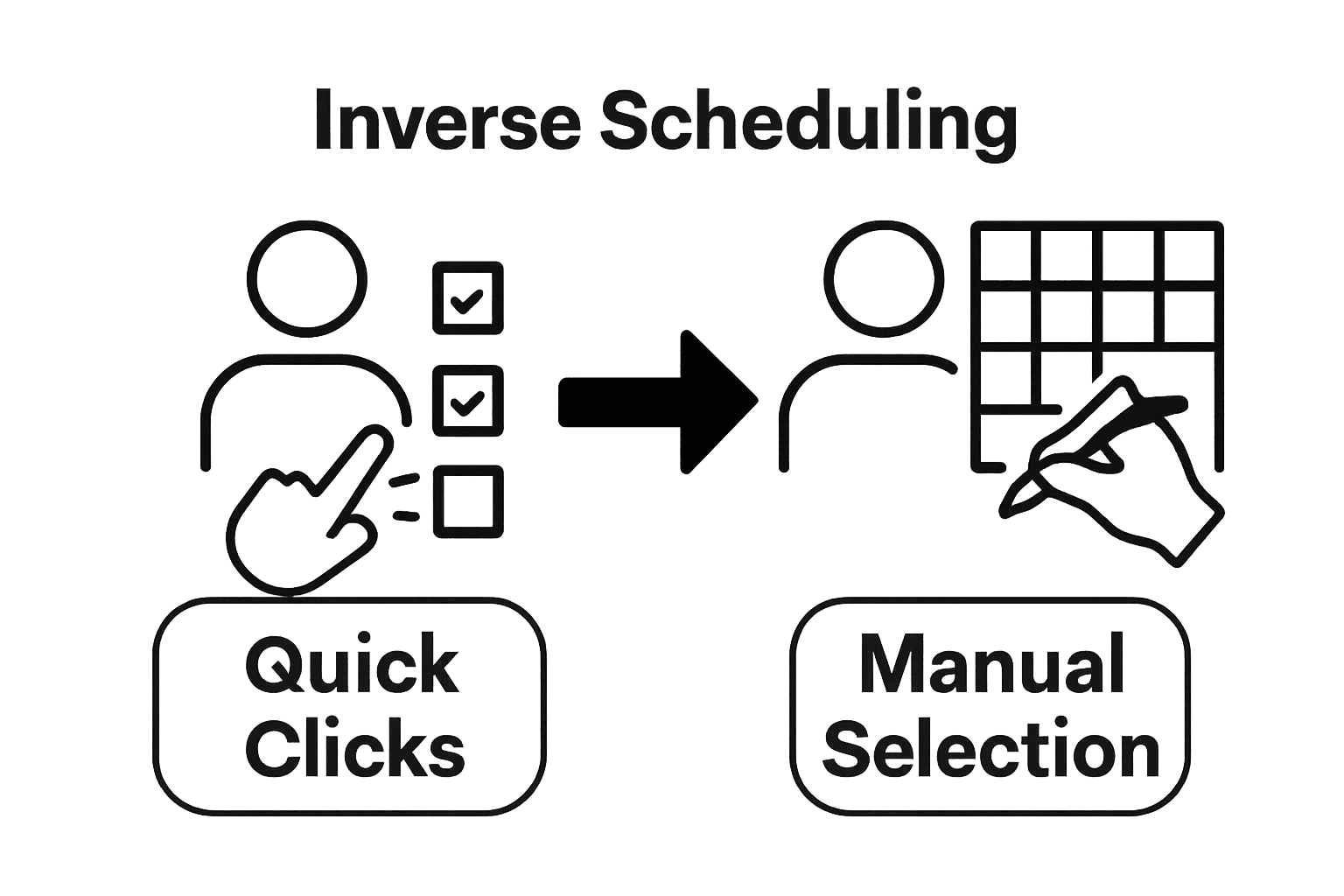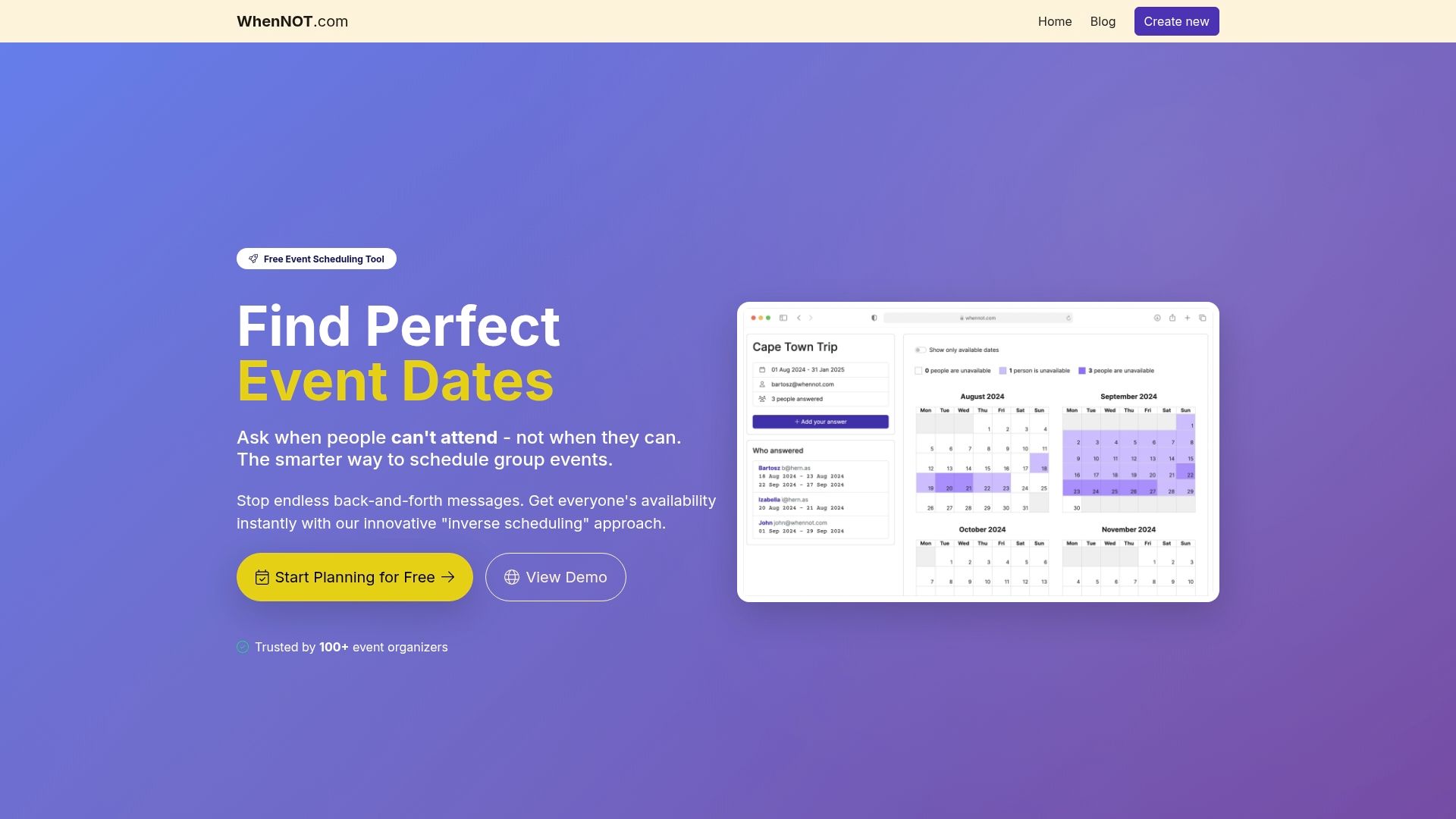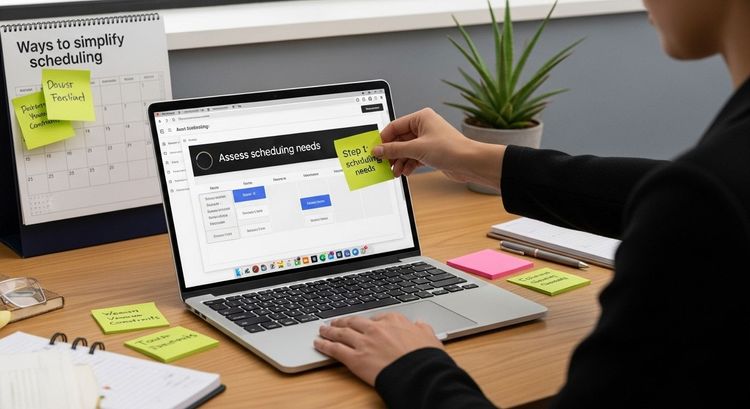Planning an event might seem simple on the surface. Yet nearly 67 percent of meetings fall apart because of scheduling conflicts or miscommunication. So why do so many groups still struggle to agree on a date? The smart move is to treat scheduling as a strategic process instead of a scramble, opening the door to gatherings that actually happen and leave everyone satisfied.
Table of Contents
- Step 1: Assess Your Scheduling Needs And Constraints
- Step 2: Choose A Suitable Scheduling Tool Or Platform
- Step 3: Gather Participant Availability Data Efficiently
- Step 4: Propose Scheduling Options Collaboratively
- Step 5: Confirm Dates And Finalize The Schedule
- Step 6: Evaluate The Scheduling Process For Improvements
Quick Summary
| Key Point | Explanation |
|---|---|
| 1. Assess event needs thoroughly | Understand event purpose, participant constraints, and timelines to create a solid planning foundation. |
| 2. Select the right scheduling tool | Choose a platform that meets your specific needs to streamline communication and avoid complications. |
| 3. Gather participant availability efficiently | Use clear communication and multiple response options to simplify the availability gathering process and increase engagement. |
| 4. Propose collaborative scheduling options | Present multiple time slots for participants to choose from, fostering a sense of involvement and cooperation. |
| 5. Evaluate the scheduling process post-event | Collect feedback and document experiences to identify areas for improvement in future scheduling efforts. |
Step 1: Assess your scheduling needs and constraints
Successful event scheduling begins with a comprehensive understanding of your specific requirements and potential limitations. Before diving into selecting tools or coordinating participants, you need to develop a clear framework that outlines the fundamental parameters of your event planning process.
Start by defining the core details of your event. What is the purpose of your gathering? Are you coordinating a professional conference, a family reunion, a weekend retreat, or a community workshop? Each type of event carries unique scheduling complexities that demand tailored approaches. Professional events might require stricter time management, while family gatherings could offer more flexibility.
Carefully examine the participant landscape. How many people are involved? What are their potential availability constraints? According to Harvard Business Review, understanding participant roles and time zones significantly impacts scheduling efficiency. Consider factors like work schedules, geographic spread, personal commitments, and potential communication challenges.
Your assessment should also include a realistic timeline analysis. Determine your event's critical milestones and potential date ranges. Some events have rigid date requirements, while others allow more adaptable scheduling. Map out non-negotiable constraints such as venue availability, key participant schedules, seasonal considerations, and any external dependencies that might influence your planning.
Key verification points for a successful needs assessment include:
- Clearly documented event objectives
- Comprehensive list of potential participants
- Preliminary date range or scheduling window
- Identified critical scheduling constraints
- Understanding of communication channels
By meticulously evaluating these elements upfront, you create a solid foundation for streamlined event coordination.
Below is a checklist table summarizing the key verification points to ensure a thorough scheduling needs assessment for your event.
| Verification Item | Purpose |
|---|---|
| Document event objectives | Clarifies the event's purpose and desired outcome |
| List potential participants | Identifies everyone who needs to be involved |
| Define date range | Establishes possible scheduling windows |
| Identify scheduling constraints | Accounts for limitations (e.g., venues, key personnel) |
| Understand communication channels | Ensures effective reach and info sharing |
Step 2: Choose a suitable scheduling tool or platform
Selecting the right scheduling platform is a critical step that can dramatically simplify or complicate your entire event coordination process. Your choice should directly align with the specific needs and constraints you identified in the first step, transforming scheduling from a potential headache into a streamlined experience.
Approach tool selection as a strategic decision that balances functionality, user experience, and practical requirements. Not all scheduling platforms are created equal, and the wrong choice can lead to communication breakdowns, missed details, and unnecessary complexity. Look for tools that offer intuitive interfaces, robust communication features, and flexibility to accommodate your unique event parameters.
Consider platforms that provide transparent availability tracking, easy participant invitation mechanisms, and minimal friction for users. According to research from the National Institutes of Health, effective digital scheduling platforms should seamlessly automate reminders, manage participant lists, and synchronize across multiple devices.
When evaluating potential tools, pay close attention to key compatibility factors. Can the platform handle the number of participants in your event? Does it support different time zones? Will it integrate with calendars your participants already use? Prioritize solutions that reduce administrative overhead and make participation as simple as possible for all involved.
Key verification criteria for tool selection include:
- Intuitive user interface
- Compatibility with participant technology
- Robust communication and reminder features
- Ability to handle your specific event complexity
- Minimal technical barriers to participant engagement
Remember that the goal is not finding the most feature-rich platform, but the one that best matches your specific scheduling requirements. Sometimes the simplest tool can be the most effective, especially when it removes barriers and makes coordination feel effortless for all participants.
Step 3: Gather participant availability data efficiently
Collecting participant availability represents a critical junction in event scheduling where communication and technology intersect. The goal is to gather precise scheduling information with minimal friction and maximum participant engagement. Your approach should prioritize simplicity, respect participants' time, and create a straightforward process for sharing availability.
Communication clarity is paramount when requesting availability data. Craft a concise, direct invitation that explains the purpose of the event, provides necessary context, and clearly outlines what information you need from participants. Include specific instructions on how to submit their availability, emphasizing ease of response. The more straightforward your request, the higher the likelihood of prompt and accurate replies.
According to research on automated scheduling tools, leveraging technology can significantly streamline data collection. Choose platforms that allow participants to quickly indicate their unavailable times rather than forcing them to manually select available slots. This inverse scheduling approach reduces cognitive load and increases response rates.

Consider implementing strategies that make participation as frictionless as possible. Provide multiple submission channels - perhaps a web link, email response, or integrated calendar sharing option. Give participants a reasonable deadline for responding, and send gentle reminders as the deadline approaches. Be mindful of different communication preferences and technological comfort levels among your group.
Key verification points for efficient availability gathering include:
- Clear, concise invitation sent to all participants
- Multiple easy submission methods
- Reasonable response deadline established
- Follow-up reminders dispatched
- Comprehensive tracking of participant responses
Successful data collection transforms scheduling from a potential administrative nightmare into a smooth, collaborative process.
By prioritizing participant experience and leveraging smart technological solutions, you create a foundation for efficient event coordination that respects everyone's time and preferences.
Step 4: Propose scheduling options collaboratively
Collaborative scheduling transforms potential conflict into a cooperative problem-solving experience. After collecting participant availability data, your next critical task is presenting potential scheduling options that balance individual needs with overall group objectives. This step requires diplomatic communication and strategic option presentation.
Transparency becomes your most valuable tool when proposing scheduling options. Instead of dictating a single time slot, create an environment where participants feel their input genuinely matters. Analyze the availability data collected in the previous step to identify time windows that accommodate the maximum number of participants. Visual representations like shared calendars or color-coded availability grids can help participants quickly understand potential meeting times.
According to research on digital collaboration, effective communication is crucial when coordinating geographically distributed groups. Present multiple potential scheduling options with clear context, explaining why each time slot might work. Provide rationales that help participants understand the reasoning behind your proposed times, which increases their willingness to compromise.
Encourage an open dialogue where participants can discuss and negotiate. Create a structured yet flexible environment that allows for constructive feedback. Some scheduling tools offer voting or preference ranking features that can help you quickly converge on the most agreeable time slot. Be prepared to facilitate conversations, mediate potential conflicts, and help the group reach a consensus.
Key verification points for collaborative scheduling include:
- Multiple scheduling options presented
- Clear explanation of each proposed time slot
- Mechanism for participant feedback
- Transparent decision-making process
- Documented group consensus
By approaching scheduling as a collaborative journey rather than an administrative task, you create an inclusive process that respects individual constraints while moving toward a collective goal. The most successful scheduling happens when participants feel heard and involved in the decision-making process.

Step 5: Confirm dates and finalize the schedule
The moment of schedule confirmation represents the culmination of your collaborative planning efforts. This critical step transforms tentative discussions into a concrete commitment that requires precision, clarity, and mutual understanding among all participants. Your goal is to solidify the event details with absolute certainty and minimal room for misinterpretation.
Formal communication becomes paramount during the confirmation phase. Draft a comprehensive communication that outlines every critical detail of the finalized schedule. Include not just the date and time, but also supporting information like location, expected duration, required preparations, and any additional logistical considerations. Provide this information through multiple channels to ensure universal accessibility and comprehension.
Verify that your confirmation includes redundant communication methods. Send digital calendar invites, email summaries, and potentially follow-up text messages or group chat notifications. This multilayered approach ensures that no participant can claim they were unaware of the final scheduling details.
According to collaborative scheduling research, digital communication tools enable precise coordination across different participant contexts. Leverage these technologies to create a transparent, easily referenced record of the confirmed schedule that participants can reference at any moment.
Key verification points for schedule finalization include:
- Comprehensive schedule details communicated
- Digital calendar invites sent
- Written confirmation distributed
- Acknowledgment received from all participants
- Contingency plans established for potential changes
The most successful schedule confirmations create a sense of collective commitment. By presenting the finalized schedule as a collaborative achievement rather than an administrative mandate, you reinforce the group's shared investment in the event's success. Approach this step with clarity, respect, and a forward-looking perspective that builds excitement for the upcoming gathering.
Step 6: Evaluate the scheduling process for improvements
Scheduling is an evolving skill that demands continuous reflection and refinement. This final step transforms your current experience into a learning opportunity, creating a systematic approach to enhance future event coordination. The goal is not just to complete an event, but to develop increasingly sophisticated scheduling strategies with each subsequent planning cycle.
Comprehensive documentation becomes your strategic advantage during the evaluation process. Immediately after the event concludes, capture detailed observations about what worked smoothly and what encountered friction. Record specific challenges, participant feedback, communication effectiveness, and any unexpected complications that arose during scheduling. This granular insight prevents repeating past inefficiencies and builds institutional knowledge about your group's unique scheduling dynamics.
According to research on organizational scheduling, regularly evaluating scheduling outcomes can reveal critical patterns that dramatically improve future planning processes. Conduct a structured review that goes beyond surface-level observations, analyzing metrics like participant engagement, response times, and overall scheduling efficiency.
Consider soliciting direct feedback from participants through brief, focused surveys. Ask specific questions about the scheduling experience, communication clarity, and potential improvements. Approach this feedback collection as a collaborative dialogue rather than an interrogation, emphasizing that you're genuinely interested in understanding their perspective and enhancing future coordination efforts.
Key verification points for process evaluation include:
- Comprehensive documentation of scheduling experience
- Participant feedback collected and analyzed
- Specific improvement areas identified
- Actionable recommendations developed
- Lessons learned formally recorded
By treating scheduling as a continuous improvement process, you transform what could be an administrative chore into a strategic capability. Each scheduling cycle becomes an opportunity to refine your approach, build stronger communication practices, and create increasingly seamless collaborative experiences for your group.
This summary table outlines the main steps in simplifying event scheduling, along with their key outcomes.
| Step | Main Action | Key Outcome |
|---|---|---|
| 1 | Assess needs & constraints | Foundation for effective scheduling |
| 2 | Choose a scheduling tool | Simplifies coordination |
| 3 | Gather participant availability | Accurate understanding of availability |
| 4 | Propose options collaboratively | Increased participant buy-in |
| 5 | Confirm & finalize schedule | Clear, shared commitment |
| 6 | Evaluate & improve process | Continuous improvement for future |
Take the Stress Out of Group Scheduling with WhenNOT
Are you struggling with the hassle of collecting everyone's availability and finding the perfect event date? This article breaks down the complex process of group scheduling, highlighting how time-consuming and frustrating it can be to coordinate multiple participants, manage countless messages, and balance different time zones. If you are tired of endless back-and-forth, confusing spreadsheets, and missed deadlines, there is a smarter way to schedule your next group event.

WhenNOT is built around the very challenges described above. Our innovative online scheduling tool uses an 'inverse scheduling' approach, letting your participants mark only the days they cannot attend. It is quick, free, and does not require anyone to sign up. Simply set up your event, share a unique link, and let WhenNOT visualize the best dates in an instant. Say goodbye to endless email chains and say hello to fast, clear group decisions. Want to make your next event truly easy to plan? Get started now at https://whennot.com and turn scheduling headaches into seamless events.
Frequently Asked Questions
How can I effectively assess my scheduling needs before planning an event?
Start by defining the event's core details, including its purpose and type. Examine participant availability, work schedules, and any critical timing constraints. Documenting objectives and constraints will create a solid foundation for efficient scheduling.
What should I look for when choosing a scheduling tool or platform?
Seek a platform that offers an intuitive interface, robust communication features, and compatibility with participants' technology. Ensure it can handle your event's complexity while minimizing technical barriers to facilitate easy participation.
How can I gather participant availability data efficiently?
Use clear and concise communication when requesting availability. Utilize tools that allow participants to indicate their unavailable times easily, and provide multiple channels for submission. Set a reasonable response deadline and send reminders to ensure timely participation.
What steps can I take to confirm the finalized schedule for an event?
Draft a comprehensive communication that includes all critical details like date, time, location, and logistics. Send digital calendar invites and ensure that all participants acknowledge the final schedule. Establish contingency plans for any potential changes.
